Crafting History | Brussels Edition
Back in July, I had the incredible opportunity to visit Brussels, Belgium. A city and country rich with beer history, this trip is a bucket list destination for many connoisseurs. Belgium’s diversity of styles, centuries-old brewing techniques, and preservation of tradition have all impacted its place as one of the most culturally significant countries in the world when it comes to heritage. This installment of Crafting History features contributions from legends of the industry Werner Van Obberghen – Owner and Managing Director of 3 Fonteinen, Moeder Lambic owner Jean Hummler, and former Chairman of De Heikantse Bierliefhebbers Fons Minne, as well as reviews of a few Belgian relics – some of which have been cellared for over two decades.
Setting the Scene
A Rich History
The impact and significance of beer in Belgium’s history is immense and cannot be overstated. In fact, it’s very much intertwined with the country’s identity. In 2016, UNESCO even added Belgium’s beer culture to their cultural heritage list, deeply-rooted in representation through its vast expanse of breweries, beer tasting associations, museums and events in every province of the country.
Belgium’s beer history dates all the way back to the Middle Ages, when brewing was primarily done in abbeys and monasteries. During the 6th century, Benedictine monks started brewing beer as a way to sustain themselves and fund their monasteries. This tradition flourished, with many abbeys producing high-quality beer. The Trappist monks, in particular, became famous for their unique and strong ales, and some of their breweries still exist today.
The Industrial Revolution saw the expansion of brewing in Belgium from the monasteries to the commercial sphere, with many of the bigger names we know today – Duvel, Stella Artois, and Jupiler, to name a few – emerging during this period. After World War II, Belgian brewers began to experiment more with different yeasts, hops, and brewing techniques. The emphasis on yeast strain — particularly wild and mixed fermentations — set their beers apart from those in neighboring countries like Germany, which focused on purity laws (Reinheitsgebot) and limited ingredient lists. Trappist & Abbey ales, Lambic & Gueuze, Dubbel/Tripel/Quadrupel, Witbier, and Saisons are all styles of beer endemic to Belgium that a wider audience had the opportunity to experience post-war, continuing to build upon its global influence.
The Modern Scene
The beer scene today in Belgium has begun settling into a bit of a split objective; continue to innovate but still preserve deep-rooted traditions. New craft breweries are popping up alongside historic ones, experimenting with modern techniques while respecting the long-established history. The craft beer boom in the United States has very much reignited a respect and curiosity for Belgian beer history and culture, with many aficionados voraciously chasing beers from legendary producers like Brasserie Cantillon, 3 Fonteinen, Bokkereyder, Boftkont, Tilquin, Westvleteren, H.ertie, De Dolle Brouwers, and many others.

Educating Through Experience
While in Brussels, I visited many different local spots, and tried my best to hit some of the more famous locations that the city and surrounding regions had to offer. I also had opportunities to meet and talk with some amazing people. Their hospitality was not something I’ll ever forget, and it was important for me to share some of their insights into their businesses and the industry as a whole.
Moeder Lambic

History
Many regard Moeder Lambic as the most famous lambic bar in Belgium, however it is also considered to be one of the top beer bars in all of Europe. The original iteration for Moeder Lambic – called Chez Moeder Lambic at the time of its founding – opened on November 5, 1983 by Joël Pêcheur. Founded with a focus on breadth and a broad industrial menu, it has undergone significant development in the 40 years since.
Pêcheur left Moeder Lambic in the mid-90s for other endeavors, and there was a gradual shift toward a more independent-spirited menu. Jean Hummler, involved in Moeder lambic since 2002, took ownership of the bar in 2006 alongside his business partners Andy Mengal and Nassim Dessicy. While an unproven concept at the time to a new generation of consumers, they took the challenge head on and opened up a second location in Central Brussels after just 3 years to accompany the original in Saint-Gilles.
Jean Hummler led Moeder Lambic into a beer revival. No more was this Pêcheur’s original vision, but instead the pioneer for localization and independence in the Brussels beer scene.
Today’s Market
When speaking with Jean Hummler during the time I spent in Saint-Gilles at the Original Moeder Lambic, he had some interesting insight into the state of today’s market. He noted that in just 4 short years – from 2012 to 2015 – we saw a decisive trend from boom to peak to fall in the industry. A generation quickly transitioned into different things, developing different tastes. Then COVID hit and ignited a turning point. He went on to say that now we are living in an oversaturated market, having disconnected passion from investment entirely.
“15 years ago there was passion in brewing, but once profitability was realized, it became a commodity more than a passion project. Hazies marked the beginning of the end of craft beer; modifying tradition to appeal to the masses.”
– Jean Hummler
But Hummler has no intentions to stray from his original vision to commit Moeder Lambic to supporting small, local, and independent breweries producing expressive, high-quality beers. It is more than just a bar; it’s a symbol of Belgian beer culture at its finest. It stands as a testament to Belgium’s brewing heritage and the growing global appreciation for Lambic and other artisanal beer styles.
3 Fonteinen

History
Brouwerij 3 Fonteinen is one of Belgium’s most iconic and revered producers of Lambic and Gueuze, known for its dedication to traditional methods and craftsmanship. Officially founded in 1887 by Jacobus Vanderlinden in the village of Beersel, Pajottenland, 3 Fonteinen was nestled directly in the heartland of Lambic production. Initially operating as a blendery rather than a full-scale brewery, they specialized in blending different batches of Lambic brewed by other breweries to create uniquely complex Gueuze beers.
The most transformative period in 3F’s history came in 1953, when the blendery was taken over by Gaston Debelder. It was under Debelder’s ownership that 3 Fonteinen began the tradition of blending Lambics to create Gueuze and Kriek (a Lambic made with cherries), helping 3 Fonteinen earn a reputation for quality and authenticity. In the 1980s, Gaston’s son Armand Debelder took over, a passionate advocate of traditional Lambic brewing and blending techniques just like his father. During Armand’s leadership, 3 Fonteinen expanded its operations and began producing its own Lambic, rather than relying solely on other breweries. Armand was a purist, advocating for the preservation of traditional techniques, including the use of large wooden barrels called foeders for fermentation and aging, and the importance of blending different vintages to achieve the perfect balance in their Gueuze.
A Turning Point
3 Fonteinen emerged into the 1990s and 2000s as leaders of a resurgence in Lambic and Gueuze, emphasizing the importance of aging time, spontaneous fermentation, and natural ingredients.
But disaster struck in 2009. A thermostat malfunction in the warehouse caused a significant portion of their aging Lambic to overheat, spoiling thousands of liters of beer that had been intended for blending. The loss of this stock was devastating for the small brewery and could have been a fatal blow to the business.
However, instead of giving up, Armand Debelder and 3 Fonteinen launched a special effort to recover. With the help of their dedicated consumer base, they sold the ruined beer as an eau de vie (distilled spirit), which helped fund the brewery’s recovery. This incident became a turning point in 3 Fonteinen’s history, demonstrating their resilience and the loyalty of the global beer community.
The Modern Era
During my time in Brussels, I had an incredible opportunity to visit 3 Fonteinen’s lambik-O-droom location in Beersel and meet Werner Van Obberghen. In 2011, after Armand passed the torch to Michaël Blancquaert (Mich for short), Werner joined on as a business manager just a couple of years later. Mich had learned the craft from his uncle, and together the new duo continued to build on the traditional methods while innovating and expanding the brewery’s capacity.
Scaling Up
Lambik-O-droom opened in 2016 to accommodate growing demand. This allowed them to continue producing their distinctive Lambics and Gueuze while also progressing their expansion. 2017 marked the beginning of the Cereal Collective, a steadfast initiative from the brewery to go back to their own “garden”. They made the clear cut choice to go exclusively organic by 2020, elevating their processes in the most natural way.
While 3 Fonteinen has certainly scaled up production throughout their history, they remain incredibly meticulous in their process, producing only 2,500 hectolitres (2000-ish bbl) annually to ensure they release the highest quality. To put this into perspective, Brasserie Cantillon – 3 Fonteinen’s most comparable market competitor – produces around the same number, between 400,000-500,000 bottles per year, or about 45,000 gallons. Even with their expansion and scaled production, their beers are highly sought after by collectors because of their complexity, depth of flavor, and firm adherence to tradition.
Today, the legendary Armand’s efforts and passion have kept 3 Fonteinen as one of the premier Lambic and Gueuze producers in the world. They craft a range of Lambics, from Gueuze to Kriek, along with other fruited Lambics – some undergoing unique secondary barrel treatments – all of which are naturally fermented and aged for several years. Armand unfortunately lost a 4-year battle with cancer on March 6, 2022. Michaël and Werner were the sons he never had, and this marked an historically solemn day in the brewery’s history. The team at PorchDrinking wants to dedicate this portion of the installment to Armand’s memory, his commitment to quality and tradition in everything he did, and the impact he had on the history of Belgian beer.
De Heikantse Bierliefhebbers
History
De Heikantse Bierliefhebbers is a Belgian beer club based in Berlaar, Antwerp, Belgium. The club is dedicated to promoting the culture of Belgian beer, including organizing events and collaborating with local breweries. While small in size, their members are passionate and dedicated, with a history dating back to the late 1980s.
After a few years of ‘beer discovery’ travel throughout Belgium, the first official meeting of De Heikantse Bierliefhebbers occurred on November 19, 1987, with the goal to open a one-off regional beer café on the Hei. A little less than a year later, on November 5th and 6th, 1988, the first Heikantse Beer Festival took place, a way to let the local community enjoy all they had discovered throughout their travels and to create an appreciation for Belgian beer culture and history.
De Heikantse Bierliefhebbers are also members of the Berlaar Cultural Council, representatives specifically of beer culture. Additionally, in 2013 they officially became a non-profit organization.
A Chance Meeting
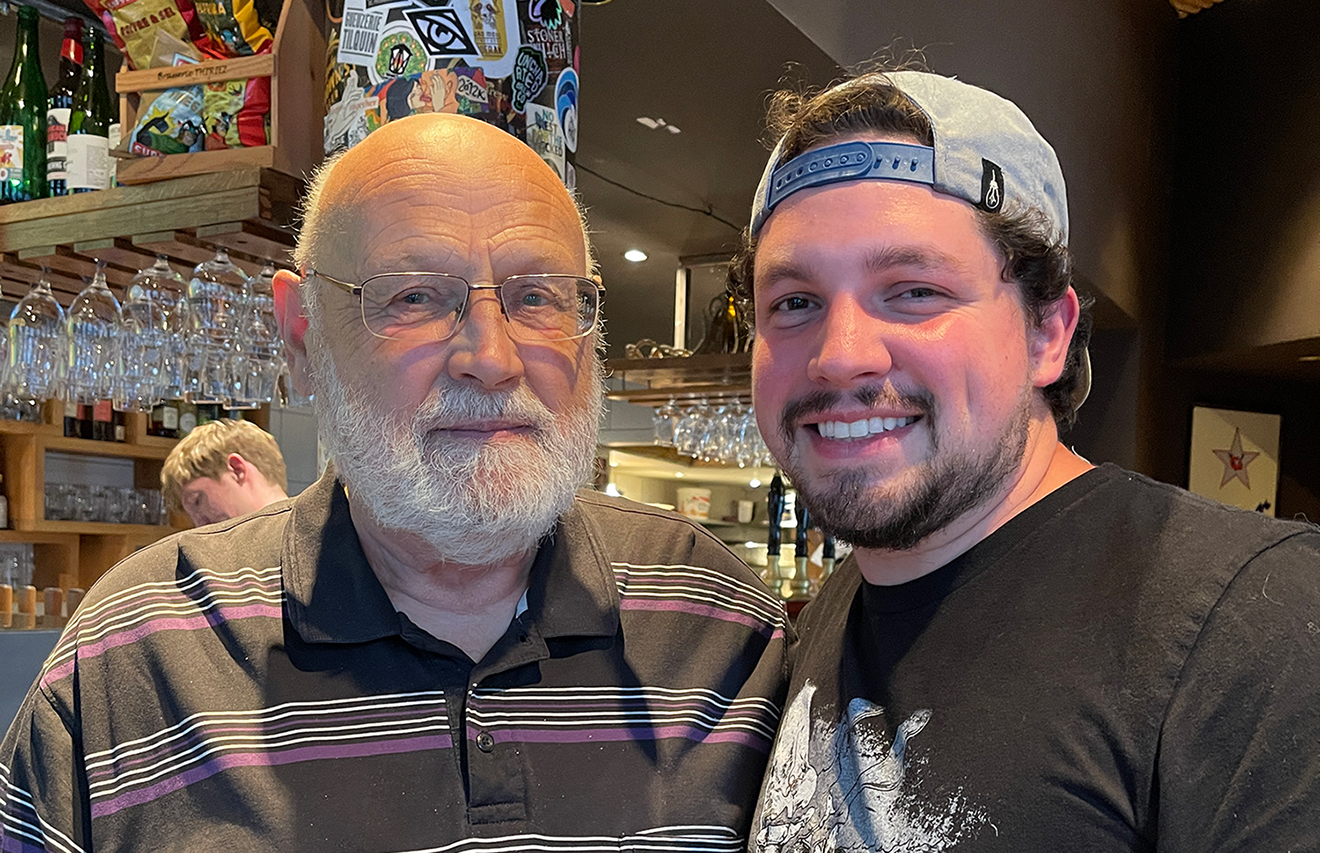
I originally connected with De Heikantse Bierliefhebbers through Dany Prignon, Head Brewer and Owner of Brasserie Fantôme, founded in 1988 in Soy, Wallonia, Belgium. Dany works closely with the organization and has for over 20 years. Fantôme also has an almost cult-like following in the United States, a fervently passionate community of consumers always on the hunt for Prignon’s enigmatic and off-the-wall creations – particularly his small-batch, vintage offerings from before the turn of the century. His allure largely stems from the extensive back catalogue of over 100 recipes and releases brewed once and never repeated, giving unique exclusivity to his creations.
Dany connected me with Fons Minne, former Chairman of De Heikantse Bierliefhebbers, who held the position until 2022 before passing it on to Luc Naets. Fons and I spoke via email off-and-on for over a year, finally getting the opportunity to meet in person during my trip to Belgium. Fons and his daughter met me at Moeder Lambic, where we had the opportunity to discuss the Beer Lovers as well as a bit of history behind one of Dany Prignon’s most famous beer releases, brewed exclusively for the Club: Caeymaex.
Caeymaex
Dany Prignon has brewed countless collaborations for and with De Heikantse Bierliefhebbers, but Caeymaex remained a one-off recipe until this year when a new iteration was released for the first time.
In 1998, De Heikantse Bierliefhebbers participated in the 200th anniversary commemoration of the “Boerenkrijg” (the Flemish peasant war against the French occupier). It was in celebration of this occasion that Dany Prignon brewed Caeymaex for them. Jan-Baptist Caeymaex was, at time of the war in 1798, Mayor of Berlaar and leader of the small peasant army that fought with the French.
During my meeting with Fons, he was incredibly generous in bringing one of the original 1998 bottles to me as a gift. The next section of this installment provides a detailed review of this 26-year-old beer. A huge thank you to Fons and De Heikantse Bierliefhebbers for the incredibly rare opportunity to taste such an historic Belgian beer.
Reviewing History
Drinking beer was of course a large part of this trip; experiencing culture through these legendary brewery’s respective craft. There were so many highlights, however a few in particular stood out in my mind as truly special. I’ll be highlighting three different vintage Belgian beers from three different producers, opened or acquired from the three major locations in and around Brussels that I had the privilege to visit.
Brasserie Cantillon | Gueuze 100% Lambic Bio (2012 Vintage)
Cantillon’s Classic Gueuze is one of their flagships, and a core part of their lineup alongside famous beers like Kriek 100% Lambic Bio, Iris, Fou’ Foune, and many others. Although its extensive history includes a bottle log dating back to 1982, they didn’t bottle it again until 1994. Since then, however, they have brewed it nearly every year. It remains one of the most common bottlings to find both in Belgium and abroad, though they have made numerous label changes over the years.
It is also important to note that there is no difference between the U.S version of “Classic Gueuze” and the 100% Bio/Organic bottles. The differences stem from different requirements by the United States versus the European Union in declaring a product organic. Cantillon currently does not meet U.S standards, but notes on its website that it has used 100% organically grown grain for its lambics since 1999.
While visiting Moeder Lambic Original, Jean Hummler suggested opening a 2012 bottle of Gueuze, as he noted that this particular year had reached a very approachable drinkability. Thank you again to Jean for his hospitality, and for this fantastic recommendation of a true Belgian classic.
The Review
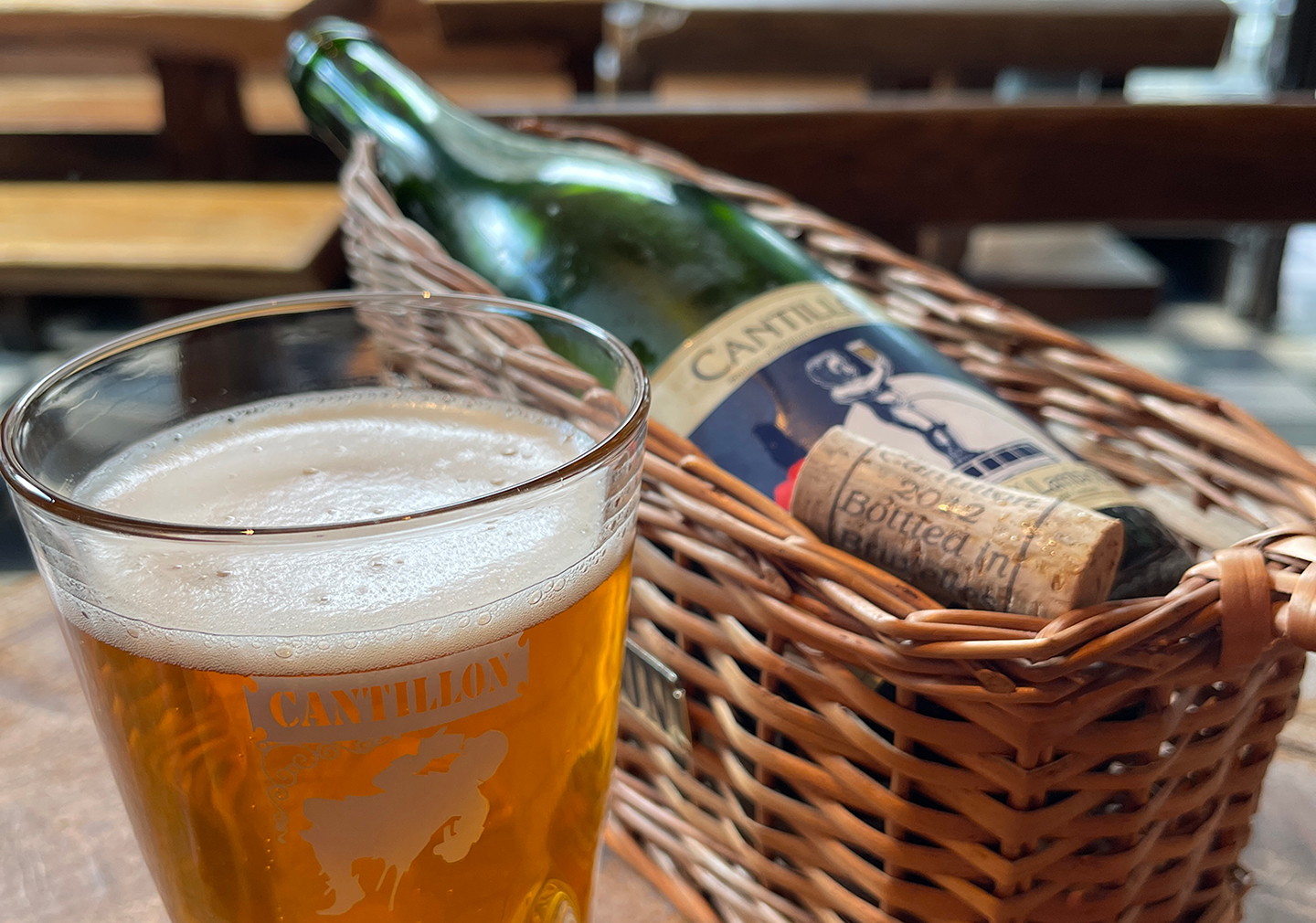
On the pour, the golden-hued liquid stirs up the perfect amount of carbonation. It lazily falls back into the beer, soaking in fresh air for the first time after 12 years.
The nose brings with it a vinous quality, lifting the musty undertones to the forefront. Riding alongside are softer notes of lemon peel and a touch of zest to accompany.
The palate – like with the nose – can be characterized as distinctly soft, a beautiful warm-weather drinker that carries with it a restrained tartness as well as drying tannins on the finish. After the extended aging we noticed the oak influence really beginning to blossom, continuing to add layers to the complexity of this famous release.
When visiting Brasserie Cantillon earlier in the trip I also had the opportunity to try the 2024 vintage of Gueuze 100% Lambic. Even fresh it comes on very soft. That said, it’s a bit more floral, with evident notes of stone fruit, lemon, and apple that has it drinking similarly to a white wine. The finish is not quite as dry, but the funkiness definitely takes a backseat in comparison to what we experienced from the 2012.
3 Fonteinen | Millennium Geuze
This superior blend of lambic was the best of best, hand-selected, blended, and bottled by Armand Debelder in collaboration with Willem Van Herreweghe of Geuzestekerij De Cam. Although released in the year 2000 in celebration of the new millennium, the beer was actually bottled in the fall of 1998. It contains only wheat, malt and hops, is unpasteurized, and spontaneously re-fermented in the bottle.
After touring Lambik-O-droom with Werner Van Obberghen, he pulled this incredibly special bottle from their cellar for us to share together. The generosity he showed me was astounding, and I cannot thank him enough for allowing me this once-in-a-lifetime experience.
The Review
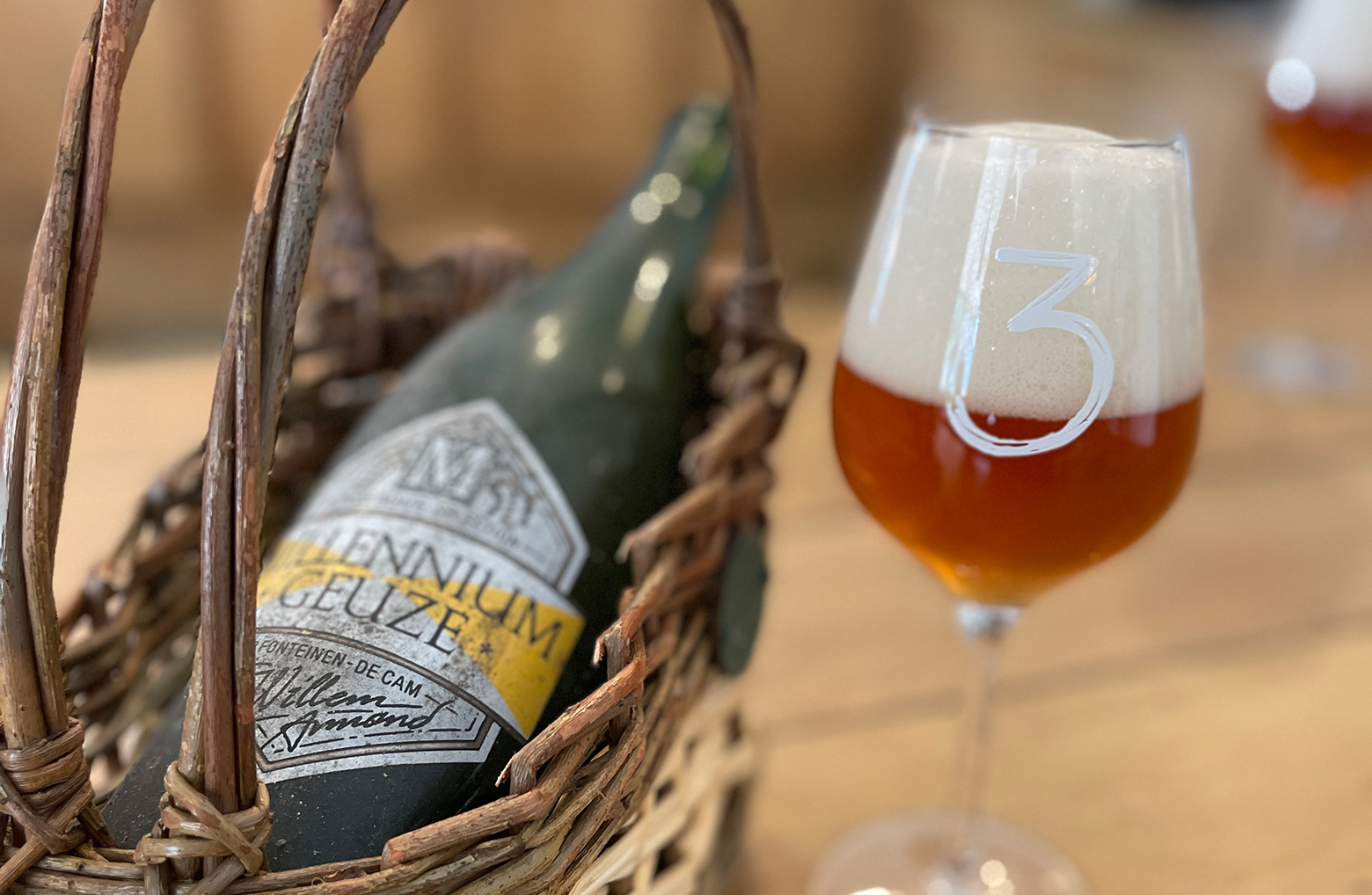
After a gentle transferral from the cellar to the basket, the cage and cork were carefully removed with equal caution. As seen in the photo above, the carbonation was still VERY active, building up to over four fingers and leaving a beautiful meringue of frothy foam above the amber-colored beer.
The nose exuded brightness, an invitation previously locked away for 26 years. A superb balance of sweet and funky accompanies closely, with hints of juicy citrus intermingling with stale must, reminiscent of the pages of an old forgotten book.
On the palate there’s a beautiful contrast from the nose of dryness and salinity. Oak character shines here, while notes of stone fruit and lemon rind bring equilibrium back to the profile.
The approachability of this beer is incredible. Soft yet textured by the carbonation. Tart and yet still fluffy and delicate. The finish removes moisture from the palate but isn’t overly dry, and the pleasant length on the finish carries with it a touch of salt, oak, and fustiness.
After over two decades in the bottle, Millennium Geuze still has so much to say. Even at the 26-year mark since its bottling, it conveys an astounding beauty in its expression of gueuze, and I can only imagine the developmental journey it has undergone over the years. This bit of history makes it easy to see how and why 3 Fonteinen were one of the leaders in the revival of the style.
Brasserie Fantôme | Caeymaex (1998 Vintage)
As briefly mentioned already, Caemaex was brewed by Brasserie Fantôme for De Heikantse Bierliefhebbers as part of the 200th Anniversary commemorating the “Boerenkrijg”, or “Peasant’s War”.
Caeymaex is a Saison-style beer, brewed on May 5th, 1998 at Fantôme. The recipe utilized four types of malt, three types of hops, spring water, yeast and four secret herbs. It is a “living beer”, refermented in the bottle. At the time it was a completely original recipe, brand new to Dany Prignon’s portfolio.
Endless thanks owed to Fons Minne for gifting me this historic bottle; it is a piece of both Berlaar history and beer history, and it’s incredible that we’re able to share the experience with our readers.
The Review
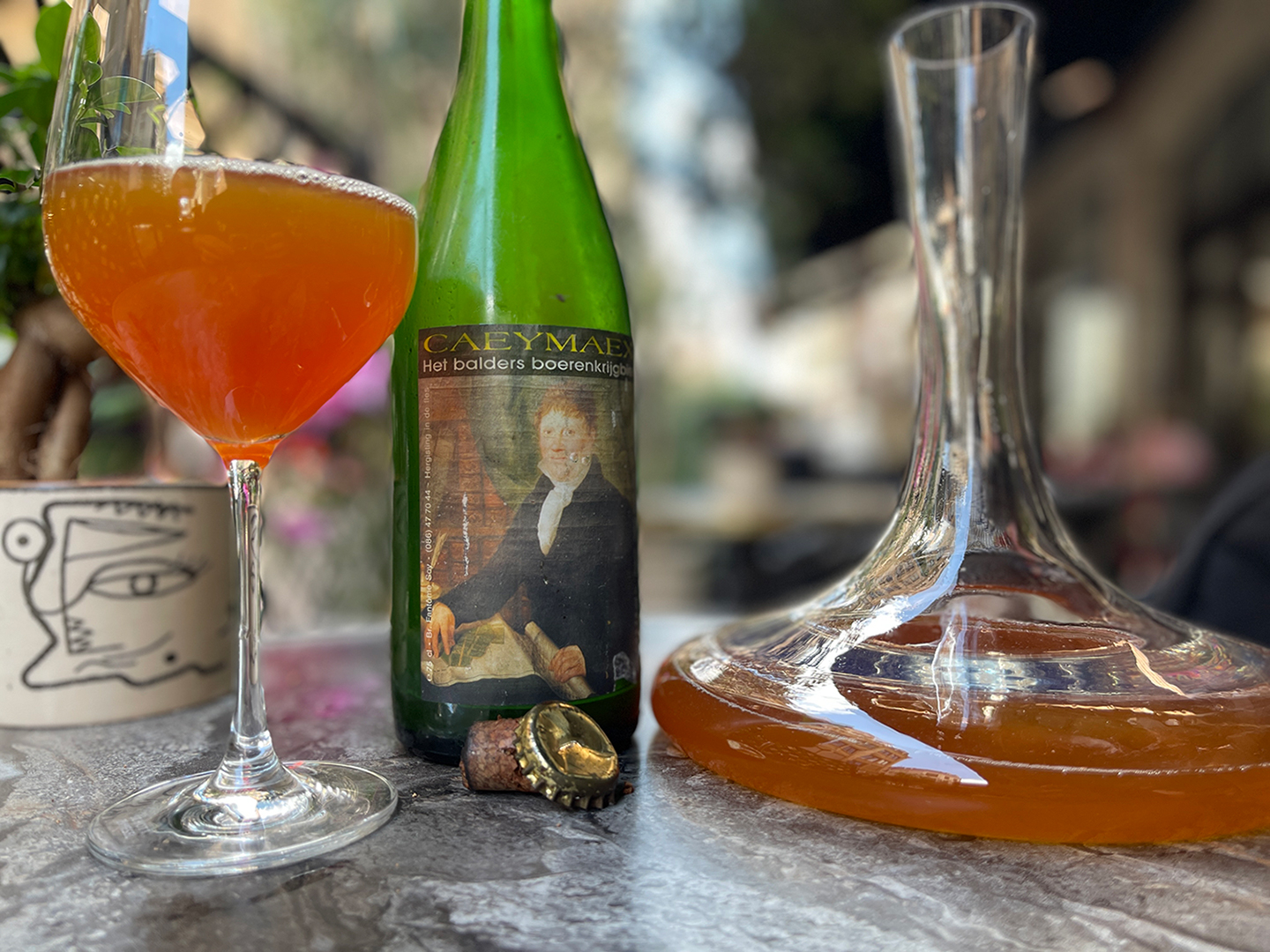
The coloration here is a bright, rust-hued amber. Completely unfiltered, and nearly opaque. Additionally, pouring from the decanter stirs up almost no discernible carbonation.
Immediately the nose comes forward both soft and mild. Notes of honey compliment a floral base. In quick succession there’s a distinctly spiced, peach-forward component that is almost similar to a cognac or even vintage Grand Marnier.
The palate contrasts beautifully in its delicacy. Soft, and still so well-carbonated for being 26 years old with a soaked cork and rusted, moldy cap. It’s fairly dry, with a damp, woody character very noticeable on the front end of the palate. It retains a noticeable albeit subtle tartness on the tail, with hints of mustiness contrasted by apricot and lemon zest brightness.
This relic has an exceptional mouthfeel, especially considering its age. Light and soft, with a perfect level of acidity. The finish is dry and tart, with beautiful length that lingers well into the next sip.
A Lasting Impact
This trip forever left its mark on me. I was able to experience one of the world’s richest beer histories, meet legendary figures in the industry, and taste vintage bottles embodying the traditions that this country holds so dear. And yet it was still only a taste. There are countless breweries, blenderies, bars, and business owners who have impacted Belgium’s beer history over the years. This isn’t meant to highlight just a few names over any others, but instead to give an idea of what you can expect should you ever have the opportunity to visit yourself.
The landscape of beer is inevitably changing, as outlined in the sentiments of Jean Hummler, or in reading the history and development of 3 Fonteinen. Adaptation and change are part of the game, but preserving the traditions and history that built the foundation we now stand on is so important. Belgium does this better than anyone, forever proud of the mark they’ve cemented in the history of beer. This culture is a proud testament to their heritage, with every sip a celebration of history, craftsmanship, and a passion passed down through generations.


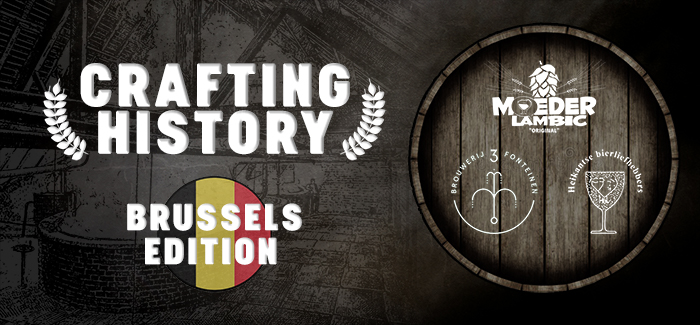

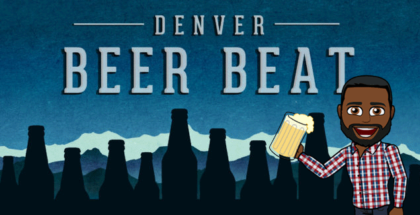
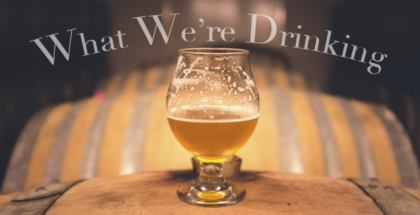
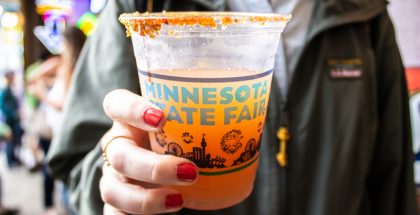
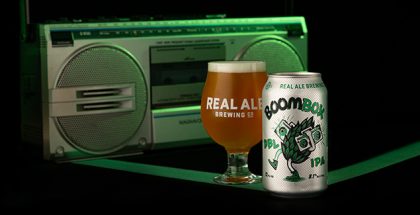
Submit a Comment